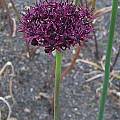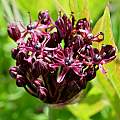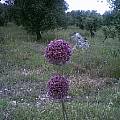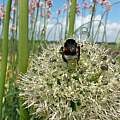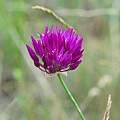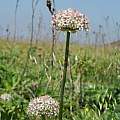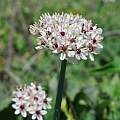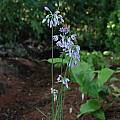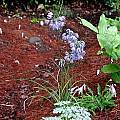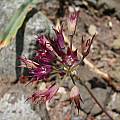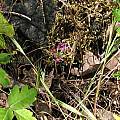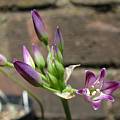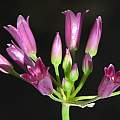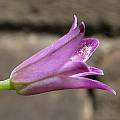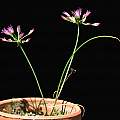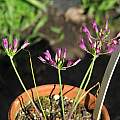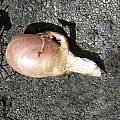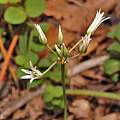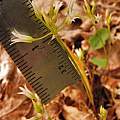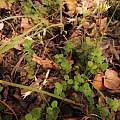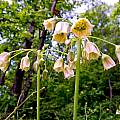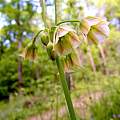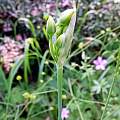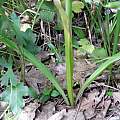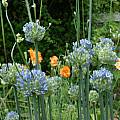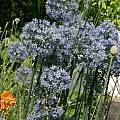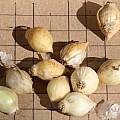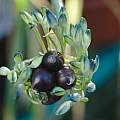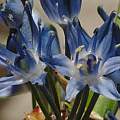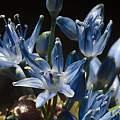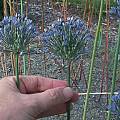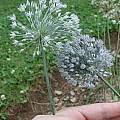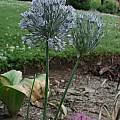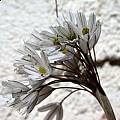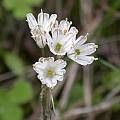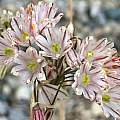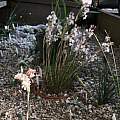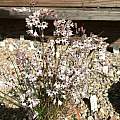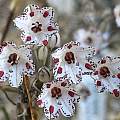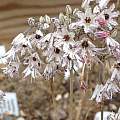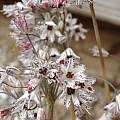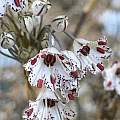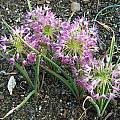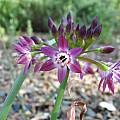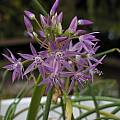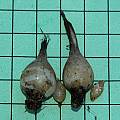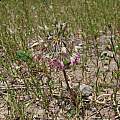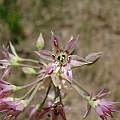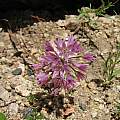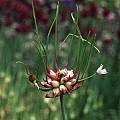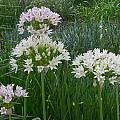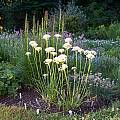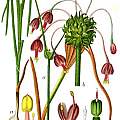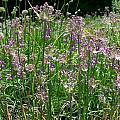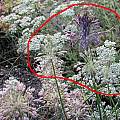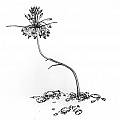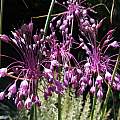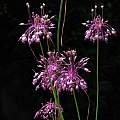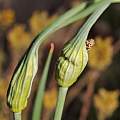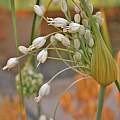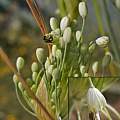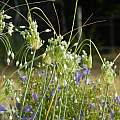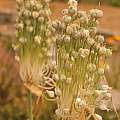This page compiles all the information and photos of the Allium taxa, cultivars, and hybrids we currently have on the PBS wiki. The Allium index gives information about the genus and includes tables of species and hybrids and cultivars.
Page 1: A. Globemaster... Page 3: A. carmeli... Page 4: A. decipiens... Page 5: A. guttatum... Page 6: A. karataviense... Page 7: A. membranaceum... Page 8: A. paradoxum... Page 9: A. regelii... Page 10: A. serra... Page 11: A. tardiflorum... Page 12: A. vineale...
Allium atropurpureum Waldst. & Kit. is found in cultivated ground and dry open spaces throughout the Balkans. The flowers are dark, dark red-purple with black ovaries. The stems are about 24-30" (60 - 75 cm) and flower in June. Mark McDonough has never succeeded in growing this from seed, so purchased bulbs gave him the jump-start he needed. Photos by Mark McDonough and Martin Bohnet.
Allium atroviolaceum Boiss. is a tall species with a 4" (10 cm+) nice drumstick head. It grows in the Eastern Mediterranean region with its western limit in Apulia which is the only occurrence in Italy. At the time of flowering, the leaves have already dried and disappeared. It is listed as vulnerable in the Regional Red List. Photo in habitat by Angelo Porcelli.
Allium backhousianum Regel is a tall (over 100 cm) onion with greenish white flowers. It grows best in a sandy well drained medium in a sunny position. Photo by Wietse Mellema.
Allium barsczeweskii Regel is a small, yet showy species, widespread in Central Asia, growing in open grassy habitats, usually solitary, occasionally forming small clumps. Blooming in June. The photos are were taken in Kazakhstan by Oron Peri.
Allium basalticum Fragman & R.M.Fritsch is a newly described species from Syria. This robust species is 40-80 cm, belonging to the Allium nigrum group. It grows in open fields on volcanic soils, blooming in March-April. Photos were taken in the Golan Heights, Syria by Oron Peri
Allium beesianum W.W.Sm. is a Chinese species, and one of the few true blue flowered Allium species. This late summer blooming allium is often confused with Allium sikkimense. The latter flowers in July whereas A. beesianum flowers in late August to September. Arthur Kilpin Bulley (1861-1942) was a rich cotton merchant from Cheshire who founded the company Bees Seeds and employed some of the famous plant hunters and this is where the name derives from. Classification of the plant in 1914 is credited to the Scottish botanist Sir William Wright Smith (1875-1956). It is found in SW. Sichuan and NW. Yunnan. Photos by Mark McDonough, taken August 23, 2002 and one week later on Aug. 31st, with more flowers open and foliage showing:
Allium bolanderi S.Watson (syn. Allium stenanthum Drew) is a small onion growing in decayed granitic soil under native oak trees in California and Oregon. The bulbs are smooth, elongated, and less than 1/2" in length. Bulbs are connected to the plants by a delicate white rhizomes. It requires a very dry summer with absolutely no water. Photos are taken by Nhu Nguyen. The 1st photo shows a darker form of the species. The 2nd photo shows an in situ shot in Yolo County, CA, growing among poison oak.
The photos below were taken by Nhu Nguyen. The 3rd and 4th photos are closeup photos of the flowers and inflorescence. They also show the powdery quality of the underside of the tepals. Photo 4-5 shows the bulbs dividing from two to four bulbs. The last photo shows the bulb which lays in the ground horizontally just as pictured here. The remnants of the rhizome can be seen on top of the bulb.
Allium bolanderi var. mirabile (L.F.Hend.) McNeal (syn. Allium mirabile L.F.Hend., Allium roguense M.Peck) is a small white flowered variety native to Southern Oregon and Northern California. It bloomed in June in Rogue River, Oregon. Photos by Travis Owen.
Allium bulgaricum (Janka) Prodan (syn. Nectaroscordum bulgaricum Janka, Nectaroscordum siculum ssp. bulgaricum (Janka) Stearn) is often confused with Allium siculum Ucria. In 2024 Plants of the World Online and World Flora Online consider it a synonym of Allium siculum ssp. dioscoridis (Sm.) K.Richt. It is native to the Mediterranean and adjacent areas (Romania to Turkey). The Dutch bulb industry has popularized this plant, which has drooping, bell-shaped flowers. Allium siculum and Allium bulgaricum are a taxonomic nightmare where some authors placed them in the same species and others separated them. The plant enjoys full sun and good watering while growing. It is a late winter/spring grower in Berkeley, CA and flowers late May-June in early summer. Photos from iNaturalist were taken of Allium siculum ssp. dioscoridis by katunchik in Bulgaria in May and shared under a CC BY-NC license.
Allium caeruleum Pall. (syn. Allium azureum Ledeb.) is readily available, inexpensive, free flowering and very pretty in the garden. Its native range is from eastern Europe to China. This species, here photographed in the Maryland, USA garden of Jim McKenney in early June 2005, seems to require dry summers to persist from year to year. As the plants get older, the umbels tend to become irregular and bulbiferous. But the wonderful color does not change. The orange flower seen in one of the photographs is the perennial poppy variously known as Papaver atlanticum or P. rupifragum. The poppy and the blue onion make a cheery late spring combination. Photo 3 by M.Gastil-Buhl shows bulbs on a 1 cm grid. Photo 4 by David Pilling displays bulbils in the flower head.
Allium caesium Schrenk - a deep blue form from Antoine Hoog. This Central Asian species is variable and occurs in a number of different forms and shades of blue. Previously I have grown a soft gray-blue form, but the dark blue form shown in the first picture is also attractive, flowering in early summer. The next two photos illustrate two more forms, collected from Central Asia by Arnis Seisums, showing the variability of the species. The flower heads are large and a beautiful pale yet rich milky blue color. Both photos taken in June 2004. All photos by Mark McDonough.
Allium callimischon Link is native to Albania, Greece, and Turkey. It has two subspecies. Ssp. callimischon is found in Albania and Greece and has white unspotted flowers with a reddish-brown vein. Although the flower stalk is formed in spring, the leaves shrivel in summer and it is not until fall that flowers appear from what looks like a dead stalk. The first photo is by John Lonsdale. The second photo by Jane McGary shows it flowering in late October on the Mani Peninsula, Peloponnese, Greece. Photos three and four by Rimmer de Vries. The last of these shows ssp. callimischon in the foreground and ssp. haemostictum in the background.
Allium callimischon ssp. haemostictum Stearn is native to Crete and Turkey and has 'blood spots' on the flowers as its name suggests. Photos by Rimmer de Vries. He comments that "it is green in the cool wet season October to June and brown and dry in the hot season and blooms on the dead looking brown stalks in Fall; this habit is for both sub-species. There are other dry and cool season alliums with this habit such as Allium arlgirdense. It took 4 years to get the clump in photo 4 above to size, planted in a 5 inch x 6 inch deep clay pot plunged in sand and kept dry July to September".
Allium campanulatum S.Watson - an odd species, but one that I like nonetheless. It flowers in early spring, preferring clay soil in a raised bed, in full sun. The flowers are nearly at ground level and typically show a two-toned flower, the center of each flower being pale compared to the deeper ends of the tepals. The stems are very brittle and easily broken. The flowers are different from most other American alliums in that they open completely where the tepals lay on a flat plane. They are found in California, Nevada, Oregon and Washington states. The mother bulb produces numerous offsets. First photo by Mark McDonough, second photo by Nhu Nguyen at the UC Botanical Garden. The last two photos were taken by Mary Sue Ittner including a picture of the bulbs on a 1 cm grid.
The photos below were taken in habitat by Nhu Nguyen on July 17, 2009 in the high Sierra Nevada near Sonora Pass. In this area there are two slightly different color forms. Both of these are found on sandy soil in full sun.
Allium canadense L. "red bulbil form from Texas" - Typical Allium canadense is best avoided as a weed because most of the flowers are replaced by bulbils, and aside from being ugly, the bulbils drop off and start new plants. Over the years I've kept just this one form with its white red-tipped bulbils, occasionally sputtering forth a white bloom or two. With the green sprouting tips to the bulbils, I thought the plant had a whimsical appearance and was thus appealing. Each year I would cut the stems off, then bag and discard the promiscuous propagules. Now I wish I had kept a few, because last summer a wild animal dug up and ate the clump! (there are foxes in the yard, and they've taken to digging and eating some alliums, particularly A. paniculatum). Photo by Mark McDonough.
Allium canadense forma florosum - This is a rare non-bulbilliferous form of the weedy A. canadense, the type species being weedy on account of the many bulbils that replace the flowers. The plants shown here were collected by Thad Howard in Texas, found in a couple locations growing amongst millions of the normal weedy types. This name, proposed by Thad Howard, has not yet been published, yet this is a highly ornamental form with large heads of white to barely tinged pinkish flowers, and rarely 1-3 obscure bulbils. In the second "garden view" of the same plant, you can see what a fine statement it makes in the garden, growing to about 30" (75 cm) tall, flowering in June. Photos by Mark McDonough.
Allium cardiostemon Fisch. & C.A.Mey. has black currant purple flowers in summer and is native to Iran and the Caucasus. It needs a dry summer rest. Photo by John Lonsdale.
Allium carinatum L. is from much of Europe into Asia, naturalized elsewhere (the Brittish Isles). Informal sprays of little rose-purple, rose-pink, to white flowers dangling on very long slender pedicels, sometimes with bulbils (though many selections are bulbil-free). Illustration below showing many green bulbils from "Deutschlands Flora in Abbildungen (nur Tafeln)" (1796) Stuttgart Anzahl gescannter Seiten: 883.
Allium carinatum ssp. pulchellum (G.Don) Bonnier & Layens is a European species that is very close to Allium flavum, flowering at the same time in June or July depending on the variety grown. The second photo is of a a dwarf bluish-purple form and a creamy white form, collected on Mt. Olympus, Greece. This is the plant that was offered by Hoog & Dix as a blue-flowered form of Allium flavum ssp. tauricum, but it is undoubtedly a "pulchellum" variant. Since the photograph shows such a confusing jumble of flowers, I circled the topic species in red. Behind the blooms are the white flowers of an Achillea and pinkish A. flavum ssp. tauricum in the foreground. Finally there is a drawing of a dark pink form. Photos #1-2 and drawing #3 by Mark McDonough. Photos 4-5 were taken by Nhu Nguyen.
Allium carinatum ssp. pulchellum f. album is a white form often sold by Dutch bulb dealers. Photos below by Travis Owen of an adaptable selection. It has thrived in sun and shade, though it flowers better in the sun. The leaves are nearly evergreen in irrigated beds, dying down after new leaves have already broke the soil surface. The third photo shows a tiny bee, shorter than a pencil is wide, visiting the florets. The last photo shows the seed pods, like most Alliums the florets turn up for the seeds to ripen.
Page 1: A. Globemaster... Page 3: A. carmeli... Page 4: A. decipiens... Page 5: A. guttatum... Page 6: A. karataviense... Page 7: A. membranaceum... Page 8: A. paradoxum... Page 9: A. regelii... Page 10: A. serra... Page 11: A. tardiflorum... Page 12: A. vineale...
Allium index - Allium flavum Relatives - American alliums A-F - American alliums G-Z - Big Ball alliums - Blue alliums - Chives - Domed alliums - Drumstick alliums - Rhizomatous alliums
